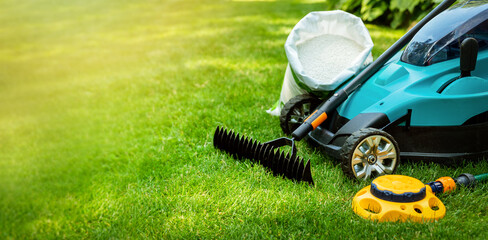One of the most important features of a lawn is its visual appeal. While many enjoy strolling along a lawn, others prefer to play sports in green spaces. Regardless of the purpose of a lawn, there are certain ways to keep it looking great. These methods include mowing the lawn regularly, fertilizing, and applying a deer-resistant weed control solution. Below are some of the best tips for taking care of your lawn.

When fertilizing a lawn, remember that winter is the best time to do it. In winter, grass stores nutrients in its roots and will be ready for a jump start in the spring. Then, the ground temperature will warm up enough in the spring for a lawn to thrive. A lawn can look great and thrive year-round with the right fertilization routine. So, when you’re planning your lawn, make sure to contact a professional. You’ll be glad you did.
Avoid using weedkillers. Weed-killers and fertilizers may inhibit plant growth. But what if your lawn suffers from a weed problem? A common solution is a fungicide. But these chemicals can harm your lawn as well. Some can cause leaf senescence, which results in brilliant fall colors in some trees. Adding more fertilizers to your lawn will also cause it to become more susceptible to weeds.
The pH level of the soil is also an important consideration. Slightly acidic soil is the best for most lawn grasses because it is most receptive to nutrients. Both dolomitic and calcitic limestone contain calcium and magnesium. Too much magnesium can cause damage to the lawn. If you have a magnesium deficiency, this kind of soil will raise the pH level. A ph level of 5.6 or more is ideal for lawn health.
Dozens of different types of grass are commonly used for lawns. Grass types vary widely. Some are coarse and suitable for active sports, while others are fine and better for ornamental purposes. The grasses that are best suited to your climate are also adapted to specific regions. For example, a cool-climate lawn needs different weed control treatments than a hot, sunny lawn needs. This is why determining the grass type and climate will be so important.
The history of lawns goes back about 900 years. Lawns were once common features of manor houses and wealthy estates. The original meaning of lawns was communal grazing pastures. However, as time went on, people began using grass in their landscapes for sport and leisure. Ultimately, lawns were developed for aesthetic and functional purposes.
Lawn grasses are flowering plants. Although most lawn grasses do not produce showy flowers, they do have reproductive structures like other plants. These reproductive structures are compacted into miniature flowers known as florets. While they are small and inconspicuous, these flowers are still important to a lawn. If you’re wondering how to take care of your lawn, here are some tips for you.
Choose a good grass type. Before buying turf, research the climate in your area and choose a type that will thrive. Consider whether the grass will be used for landscaping and whether it will survive pets and foot traffic. If you’re installing a lawn for a residential or commercial property, choose a variety that can withstand the environment. That way, you’ll be able to enjoy the beauty of a lawn for many years.
Mites are another important pest on your lawn. While many think of mites as spiders or ticks, they are closely related to them. They live in the soil, water, and even on our faces! The most common pests are clover mites and Bermuda grass mites. These mites feed on the grass and can cause it to become brown. During feeding, the mites inject toxic saliva into the grass.
Grubs are another major pest in lawns. Grubs can easily cause patches of brown grass on your lawn. However, you can also kill them with milky spores. These little creatures love the moisture and nutrients provided by a healthy lawn. You can sprinkle these on your lawn for easy cleanup. If you’re looking for a lawn treatment solution, you can use neem oil or milky spores.